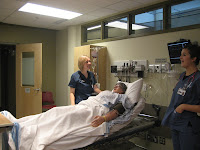If you want a golden rule that will fit everybody, this is it: Have nothing in your houses that you do not know to be useful, or believe to be beautiful.
----Norman, P227
The time has come to concentrate on making the world a Human-tech Revolution could have a profound impact on modern times. Technology that has a close affinity with human nature is capable of creating tremendous social changes, on a global scale. It could radically improve our lives and those of our children and grandchildren.
----Vicente, P305
Finishing reading the last chapters of both Norman’s and Vicente’s book, I could not help imaging our future lives filled with emotional design and a Human-tech revolution. What will our lives look like? Perhaps, one day, all of the following imaginations will be turned into reality. We don’t need to be upset for the errors or accidents caused by the inconsiderate ill-designs, as human-tech make an optimization for human beings. We don’t need to worry about the traffic jams in a rush hour, as all of us drive our own air vehicles, something like the combination of a mini-couper and a helicopter. We don’t have to take time for boring chores, as our robot housekeepers are responsible for them without our reminders, so on and so forth.
You might tease me that the dream is too big to be true, but, can those people living in 1970s imagine the development of computer technology, such as internet, dramatically changes the world as we are currently experiencing? No matter which technology of industry that was talked about in Norman’s and Vicent’s book, it is the design matters. The purpose for any design or technology is to have better lives for human beings. We are all designers, every of us can make a difference for the world, not only those engineers who grasp advanced technology on software and hardware can design and produce objects, but we, as a ordinary custom, can make each ready-made object personalization and customization.
Certainly, as for the development of a certain technology and its application, to a large extent, it is the manufacturers, organizations, governments and a country to make the final decision. However, as citizens, we absolutely have rights to call for the well-design filled with consideration of human-tech, as “we may not have any control over the design of the many objects we purchase, we do control which we select and how, where, and when they are to be used (Norman, P224). ” In other words, our decisions have a great impact on the marketing, which greatly affect designer’s ideas and behaviours. In return, their designs fit us and benefit human beings.
We can try to do our best to make a difference for our future lives. Below is a video clip for the future lives in 2050. It visions nearly all the aspect of our future lives. That’s so cool. With well-designed technology, it is not just a dream!
















